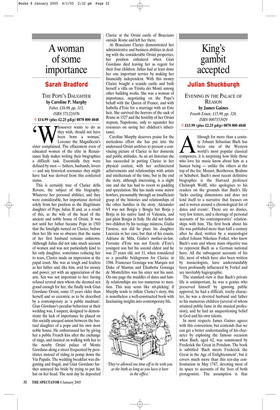A woman of some importance
Sarah Bradford
THE POPE’S DAUGHTER by Caroline P. Murphy Faber, £16.99, pp. 315, ISBN 571221076 ✆ £14.99 (plus £2.25 p&p) 0870 800 4848 ‘Whosoever wants to do as they wish, should not have been born a woman,’ Lorenzo the Magnificent’s sister complained. The effacement even of educated women of the elite in Renaissance Italy makes writing their biographies a difficult task. Essentially they were defined by men — fathers, husbands, lovers — and any historical resonance they might have had was derived from this conferred status.
This is certainly true of Clarice della Rovere, the subject of this biography. Whatever her personal abilities, and they were considerable, her importance derived solely from her position as the illegitimate daughter of Pope Julius II and, as a result of this, as the wife of the head of the ancient and noble house of Orsini. It was not until her father became Pope in 1503 that the limelight turned on Clarice; before then her life was so obscure that the name of her first husband remains unknown. Although Julius did not take much account of women and was not particularly kind to his only daughter, sometimes reducing her to tears, Clarice made an impression at the papal court. She was as tough and fearless as her father and, like him, avid for money and power, yet with an appreciation of the arts. Sex was not important to her: having refused several men whom she deemed not grand enough for her, she finally took Gian Giordano Orsini, some 15 years older than herself and so eccentric as to be described by a contemporary as ‘a public madman’. Gian Giordano’s peculiar behaviour at their wedding was, I suspect, designed to demonstrate the lack of importance he placed on this socially unequal union between the bastard daughter of a pope and his own most noble house. He embarrassed her by giving her a public French kiss after the exchange of rings, and insisted on walking with her to the nearby Orsini palace of Monte Giordano along a street frequented by prostitutes instead of riding in pomp down the Via Papalis. The wedding breakfast was disgusting and frugal, and Gian Giordano further annoyed his bride by trying to put his hat on her head. The next day he deposited Clarice at the Orsini castle of Bracciano outside Rome and left her there.
At Bracciano Clarice demonstrated her administrative and business abilities in dealing with the considerable Orsini properties, her position enhanced when Gian Giordano died leaving her as regent for their four children. Julius had at least done her one important service by making her financially independent. With this money Clarice bought a seaside castle and built herself a villa on Trinita dei Monti among other building works. She was a woman of importance, negotiating on the Pope’s behalf with the Queen of France, and with Isabella d’Este for a marriage with an Este heir. She survived the horrors of the sack of Rome in 1527 and the hostility of her Orsini stepson, Napoleone, only to squander her resources on saving her children’s inheritance.
Caroline Murphy deserves praise for the meticulous effort she has put into the underused Orsini archives to present a convincing picture of Clarice in her domestic and public attitudes. As an art historian she has succeeded in putting Clarice in her physical context, with her architectural achievements and relationships with artists and intellectuals of the time, but in the end the story, although interesting, is a slight one and she has had to resort to padding and speculation. She has made some minor howlers, presumably through an insufficient grasp of the histories and relationships of the other families in the story. Alexander VI was not Borgia y Borgia but Borja y Borja in his native land of Valencia, and just plain Borgia in Italy. He did not father two children by his teenage mistress, Giulia Farnese, nor did he place his daughter Lucrezia in her care, but that of his cousin, Adriana de Mila, Giulia’s mother-in-law. Ferrante d’Este was not Ercole d’Este’s youngest son but his second eldest and he was 27 years old, not 11, when considered as a possible bridegroom for Clarice in 1504. Francesco Gonzaga was Marquis not Duke of Mantua and Elisabetta Gonzaga de Montefeltro was his sister not his aunt. On one page the muddles of dates and family relationships are too numerous to mention. This may seem like nit-picking: if Murphy tends to inflate Clarice’s story, this is nonetheless a well-constructed book with fascinating insights into contemporary life.










































 Previous page
Previous page